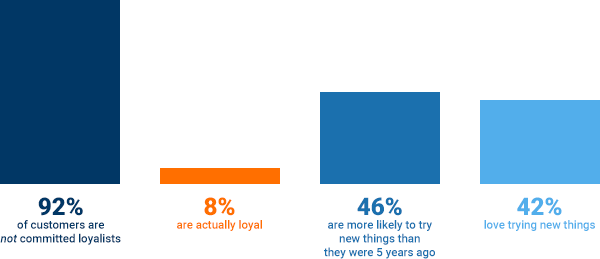A New Study Shows Disloyalty is the New Norm

The writing has been on the wall for quite sometime now. Whether you are a devoted follower of Byron Sharp, a strong believer in the heavy buyer fallacy, or a heretic who knew the Pareto Ratio would never stand up to the pressures of consumerism; loyalty ain’t what it used to be.
This truth is highlighted in a recent study from Nielsen that states 92% of people are actually not committed loyalists, finding only a mere 8% of us are actually loyal to our brands. These days, consumers tend to be on the lookout for newer, shinier things, with an increased willingness to leave their current brands. A highly-competitive market space provides a constant bevy of buying options, and a quarter of customers are now reviewing products at an increasing rate.
The decline in brand loyalty must come as quite a shock to most, given the amount of retargeting and prior-purchase campaigns there are in market these days. Many brands are forking over top-dollar for data and signals that can help them find their doting beloved so they can coerce yet another purchase from the store. Looking at the numbers, one might wonder if all of these retargeting and remarketing efforts are truly delivering.
The reality is that in order for brands to grow they need to continuously introduce new customers, steal share from competing brands, and bring lapsed customers back into the fold. The key to efficiently executing this approach is through proper audience targeting–creating the right audiences to receive the right message.
What might motivate a new customer to switch could be entirely different than what could motivate someone to come back. The effective building of audiences, using all relevant and available data, is a critical component to every campaign’s success.
Affinity Answers has created an audience targeting model that builds audiences based on the key interactions between people and the brands, influencers, sports and media entities (movies, TV, music) they engage with on Facebook, Instagram, and Twitter. Affinity Answers’ model analyzes billions of content engagements from 400MM people across 50,000 entities to create an act-alike model. Simply put, an act-alike model is an advanced look-alike model that works like a recommender engine (similar to that of Netflix or Amazon).
This approach is proven to be a better predictor of future purchase intent and behavior than past-purchase signals. Our clients use this method to find their next new customer, conquest their competitors at a brand level, or better amplify their sports and media partnerships.
Loyal buyers can’t be blindly trusted to keep coming back—in order to grow you must get new customers coming in.
Let us help you get started knowing your audience. Contact us at audiences@affinityanswers.com today.
Josh Raper
VP, Marketing


